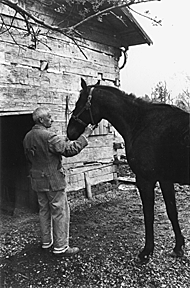William Faulkner at Rowan Oak, his home outside Oxford, Mississippi, 1962. Photograph by Martin C. Dain. Image found here.
at Rowan Oak, his home outside Oxford, Mississippi, 1962. Photograph by Martin C. Dain. Image found here.
I’ve just finished having a look at Edouard Glissant’s book, Faulkner, Mississippi (you can find some preliminary comments over at my other blog). Short review: I don’t know if he’s right (see below), but he’s a thoughtful and provocative reader of Faulkner.
Back in a 1992 summer institute at LSU, I had the privilege of hearing Glissant, so his notion of Faulkner as a Caribbean writer–within the context of Glissant’s trope of the Plantation–which he explores in Faulkner, Mississippi, was not entirely new to me. But what I didn’t remember him discussing at LSU is his take on the place of black people in Faulkner’s vision of the South. What follows, then, are some passages that I hope will serve as a fair summation of that view.
For what it’s worth: Glissant genuinely admires Faulkner’s refusal to look away from his central theme of “the human heart in conflict with itself” as that theme applies to the South’s tragedy; even so, I think he also makes clear why many African-American readers have real troubles with Faulkner’s depictions of black people–though not, perhaps, for the reason(s) they or Faulkner’s white readers would offer by way of explanation for their ambivalence toward him.
In this hidden inquiry into origins (of the county and its maledictions), to which his works always give (or rather propose) answers that are postponed (into the infinity of Time and Death), Blacks are and represent the unsurpassable point of reference, those who remain and who assume.
Here, we find that the extended African family has no claim to constitute a family lineage. So it never meets with failure [. . . .] On Faulkner’s agenda, the only means of change for Blacks would be miscegenation: the advent of hte mulatto, some sort of genetic and cultural Snopes. That, at least, is what we read between the lines. (59-60)
More below the fold.
Among the historians of the South, especially the antebellum period, there are still those who attest to a real and indisputable cultural interaction, an “interchange,” between Whites and Blacks, in social mores, art, music, religion, crafts, work, and leisure. There are others who add nuance to this observation. The question is this: Is the South a society with two intertwined cultures, one dominant and the other dominated, or a society that combines two separate and distinct cultures? But “interchange” can exist without cooperation. So the question that remains unanswered is essentially this: is cultural interaction or “interchange” a harbinger of intermingling, miscegenation, and finally Creolization? (69)
[I]n the view of his biographer Frederick R. Karl, [Faulkner] pretends that what should have been realized there was a unique, Black-and-White race. It is clear that he did not use the term “miscegenated.”
The Black-and-White race resolves unbearable hates and absolves injustice, but preserves all absolutes. Black and White are absolutes; the half-breed is anathema. Still, Sam Fathers [in “The Bear”] was not a half-breed, but Black and Indian. (85)
(Sam’s Indian name, Sam Had-Two-Fathers, emphasizes this point.)
The only way to live the inextricable while escaping damnation is to extract oneself from “History,” to remain self-sufficient and petrify oneself, without hope and without illusion. That is what Faulknerian Negroes do. (92)
This négresse [Nancy Mannigoe of Requiem for a Nun], this absolute person, is a good example of what Faulkner would offer as a contrast to Blacks generally, in the name he has of his conception of them–seeing them in his works as keepers of the suffering, guardians of the temple of the unspeakable, but not as an oppressed population that has the simple right to rise up against oppression. (94)
One quick comment in response, mostly, to this last excerpt’s final words, but also with regard to Glissant’s comments on mulattoes in Faulkner: If all this is right, then it becomes very tempting to read Ike McCaslin of Go Down, Moses as a solid candidate for a Faulkner character who most closely speaks for the author himself. And if that is true, then the scene in “Delta Autumn” between Ike and Roth’s lover–her clear refusal to extract herself from History (which is, ironically, the very course of action Ike has chosen through his relinquishment of his claim to his grandfather’s land)–acquires even more poignancy. She refuses to be a “keeper of the suffering.” No wonder Ike (and many critics out there who think they’re reading her but are, in fact, reading her through Ike’s eyes) can’t make heads or tails of her.
But whereas Glissant argues that Faulkner cannot (or does not want to) conceive of African-Americans as “an oppressed population that has the simple right to rise up against oppression,” I don’t think the woman in “Delta Autumn” thinks of herself as a member of such a population, either. I keep deferring my working all this out on the “pages” of this site and will have to yet again, but for now I’ll just say that she wants no part of either role. I do hope, though, that whoever might stumble across this might chime in via comments on Glissant’s claims.
Filed under: African-Americans, Creolization, Edouard Glissant, Faulkner, miscegenation, Mulatto |




[…] Black people in Faulkner’s world: Some passages from Faulkner, Mississippi […]